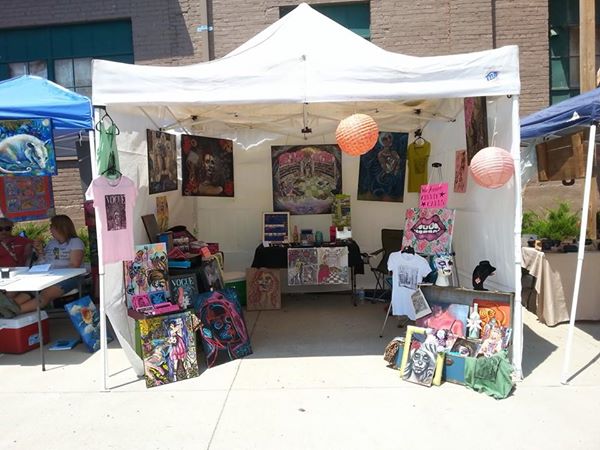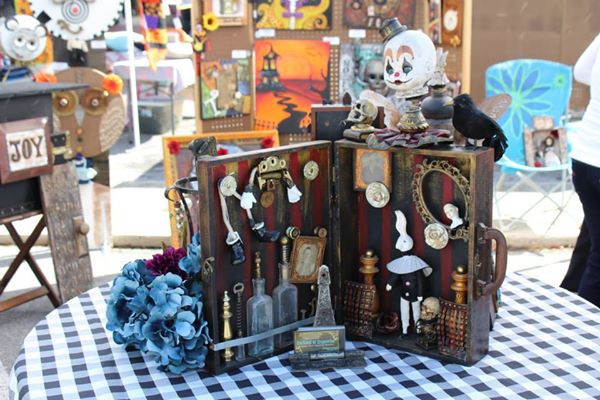
A wide variety of great arts and crafts festivals take place throughout the year in the Middle Tennessee area, but the holiday season is an especially busy time for these events. While, to some, art can be considered a frivolous luxury, during other times of the year, like Christmas, everyone is on the hunt for original, unique gifts for friends and family—and handmade gifts are a great way to go. In addition to getting a handcrafted treasure that can’t be found anywhere else, you’re also supporting your local community of artists. However, some shoppers may not quite understand the best way to communicate with artists at these events.
Most artists agree wholeheartedly that art shouldn’t be this intimidating thing that only a small percentage of the population can access and understand. It should be accessible to all types of people, and craft fairs are a great way to expose new people to art. Many who wouldn’t necessarily seek out a gallery to visit will attend a festival, and maybe it’s that unfamiliarity with the art world that makes some people forget their manners when browsing through booths.
If you’re not a creative person, or you have never attempted to sell handmade goods, you might not realize exactly how much work goes into a craft fair. It can take months of preparation and a pretty considerable investment of both money and time. When an artist first starts participating in festival there is a pretty hefty initial investment. They have to purchase a tent, tables, and whatever else they can afford to make their booth display look professional and appealing. Trying to piece together one of these displays on a tight budget is very tricky. And usually it takes quite a few rounds of festivals before a display has really reached a point of completion.
That’s only the beginning . . . having enough handcrafted inventory to fill a 10×10 foot space takes more money for supplies and a whole lot of time. Most artists accept sleep deprivation as part of the job in the weeks leading up to a fair. And then when the big day has finally arrived, they may end up with nothing at the end of it all. A good craft fair experience for an artist is making their booth rent back. A great experience is making what they spent on their booth in addition to making back what was spent on supplies. A fantastic, almost unheard-of experience is making back all of that money plus enough profit to feel as if they’ve actually been somewhat compensated for their time. But despite all of those challenges, artists are more than happy to do it. They take pride in it, actually. These fairs are an excellent way to get their work out there and possibly make some money doing what they love. But after all of that hard work, not to mention the bravery it takes to invest so much into something with no guaranteed return, they have to smile and bite their tongues as shoppers say things like, “That doesn’t look hard . . . I can do that!”
It is actually very hard. “I could make that” is probably one of the most common phrases heard by artists at fairs, far more frequently than any compliment or praise for their work. For some reason a lot of people don’t seem to consider this line to be rude. Beyond rudeness, it is actually pretty ridiculous. When you’re walking down the produce aisle you don’t refuse to pay for your groceries because you could have grown the stuff yourself. Growing a garden takes a lot of time and investment, just as making art does. The hardest part of creating something is getting the idea for what you’re going to make in the first place. But let’s say for a moment that you did in fact have an idea to make something just like what you’re seeing at a craft fair; when going to the craft store to buy materials you will likely be surprised by just how much you will spend. Then once you actually begin making it you will find the process a lot harder than you expected. The point is, maybe, just maybe, you could have made it, but did you? And will you actually make it? Or wouldn’t you rather just pay a local artist for the service they’ve provided you?
As local artist Dawna Kinne Magliacano puts it, “People who say this generally have never made one of the things they say it about, and won’t. Even if you can and will, don’t talk about it in the artist’s earshot.”
Magliacano also adds that customers should never ask how something is made. Artists don’t go through all of that work to give you a tutorial on how to rip off their ideas. What is acceptable to do, however, is to ask if they offer workshops on the particular process you are interested in. They’re not against other people making art—they encourage it. Artists want everyone to experience creativity. And sharing all of the tricks of the trade they have spent a great deal of time studying and perfecting with others is just another service they offer to their community. Respect that and pay them to guide you and teach you. The better question to ask an artist is why they did what they did.
“Don’t be afraid to ask the artist questions about their inspiration for a particular piece. Artists generally like to share about the work they have created and the story behind it,” says Magliacano.
Michelle Sweatt works in sculpture and three-dimensional mixed media work; strongly inspired by Dia de las Muertes (Day of the Dead), her work features a lot of skulls, bones, recycled doll parts, and other imagery that some may consider dark. At this year’s Greenway Arts Festival, Sweatt had to suffer through a great deal of insulting remarks about her work, including “Wow . . . your stuff is really morbid . . . kind of sick.” While the patron’s attempt at understanding and engaging with the work is certainly admirable, there were definitely better ways to phrase that. Most artists consider their work to be pieces of their soul—extensions of themselves. It takes a great deal of courage to put something so deeply personal and meaningful out there for the whole world to see. Being told it’s “morbid” and “kind of sick” isn’t exactly a confidence booster.
Artist Amy Raven says she has often heard unsolicited advice like, “Your work doesn’t appeal to everyone so if you want to be successful you should make things that are nice,” or, “Why don’t you make anything pretty?” Most artists do compromise occasionally and make pieces they feel are more appealing to the general public because they have to make a living. But artists who choose to stick with creating only what truly moves them certainly shouldn’t be chastised for doing so by their community or other artists. Our world can be a scary place, so it really shouldn’t be a surprise to anyone why some art is so dark. Creating art is how some artists cope with their fears and worries, and if you look at it with an open-mind you might find that a piece may in fact help you to feel better about your own fears and worries. Magliacano points out that such an experience is why you should buy art, not because of how it will look in your home.
“If you are buying something for yourself, buy it because of how it makes you feel, not whether it matches the paint color on the wall, or a duvet. If it moves you, and you make all your choices based on what you ‘feel’ rather than what ‘matches,’ trust me: it will be at home someplace in your home. You don’t have to explain yourself or worry about what anyone else thinks about your choices,” she said.
And for those feeling guilty over spending money on art, she goes on to explain, “Art that makes you happy does serve a function! If it brings you joy, it is serving a purpose. There is great value in spending money on making yourself happy. If you are happy you can spread it to others.”
Alicia Maynard of Lime Tiger Emporium makes a great point about justifying the price of art: Art lasts forever. That work you’re buying to put on your wall is something that you will look at every day. The same feeling you got that inspired you to buy it in the first place will overcome you every single time you look at it, repeatedly, for years to come. If you buy a $600 painting, and you divide it by 365 for each day of the year, you are only paying less than $2 a day to have that experience. If you consider a longer span of time, say 20 years, you’re paying a mere 8 cents a day for that experience. And when you think in terms of your entire lifetime you begin to understand why it is in fact priceless.
There are tons of lists and memes floating around the internet telling you what you should never, ever say to an artist. They all basically encompass these things: don’t insult or question what the work is priced at, don’t ask how it’s made, and overall just follow the rule of “if you don’t have anything nice to say, don’t say anything at all.” Next time you’re strolling through a craft fair, keep this quote in mind: “When you buy something from an artist, you’re buying more than an object. You’re buying hundreds of hours of errors and experimentation. You’re buying years of frustration and moments of pure joy. You’re not just buying one thing . . . you’re buying a piece of a heart, a piece of a soul, a small piece of someone’s life.”
If that’s not enough to make you understand why the work is priced the way it is or why you couldn’t exactly make it yourself, perhaps it will at least remind you to be more tactful when expressing your opinions of the work, even if it’s not what a piece of your soul would look like.
(Check out the November Art Happenings for a list of events you can attend and practice these Craft Fair Etiquette guidelines.)














